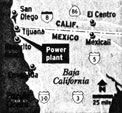 Power sharingRosarito surges with promise of averting electric crisisBy Diane Lindquist, staff writer, March 23, 2000 San Diego Union Tribune ROSARITO BEACH -At time when San Diego's demand for electricity threatens blackouts by 2004, a power plant in this coastal tourist city provides a surprising ray of hope. The plant, called Presidente Juarez, is a dirty , outdated mass of steel and concrete. Fueled by crude oil arriving in oceangoing tankers, it spews a black plume of noxious fumes into Baja California and San Diego skies. It barely produces enough electricity to supply Tijuana's needs, much less San Diego's. But by the middle of next year Presidente Juarez is scheduled to be transformed into one of the world's newest-generation power plants. Clean and fuel-efficient, it will be more modern than similar Southern California facilities.
Even more important, the plant will generate so much electricity that Mexico's Federal Electric Commission says it will be able to meet the growing demands of Tijuana, Tecate, Ensenada and Rosarito- a well as much of San Diego. Two foriegn-owned companies are helping the Mexican government built the plant. San Diego-based Sempra Energy is laying a 23-mile pipeline from the border to convert the plant to use natural gas. A Swedish-Swiss conglomerate is adding state-of-the-art generators that will double the plant's electricity output. The private companies see their participation as a preview of bigger ventures. The lure, especially for Sempra, is the possibility that Mexico will let foriegn companies construct their own power generating facilities in the country. If that happens, Sempra wants to build a power plant- or - in Baja California to sell electricity on both sides of the border. And, if Sempra or some other company built those plants, San Diego could avoid the electricity crisis it faces today. With competition, consumer electric bills could shrink as well. "If you look at San Diego-Baja California as one region, ... companies could provide power in the most environmentally friendly and cheapest way, whichever side they want to put their power plant on," said Alan R. Sweedler, director of San Diego State University's Center for Energy Studies.
The energy situation has grown critical in Baja California and San Diego County. San Diegans got a startling wake-up call at a California Public Utilities Commission meeting in January when energy experts revealed that local demand has accelerated far faster than anyone expected. Without additional supplies, they said, lights in sections San Diego will dim or go out sporadically within four years. The companies that own the existing Carlsbad and Chula Vista power do not plan upgrades anytime soon. Major additions to the transmission system, which could bring power from elsewhere, would take at least five years to complete. San Diego County's only hope for boosting its electricity supply is a power plant that PG&E Generating wants to build in Otay Mesa. But, because of a time-consuming permit process, it is unlikely to be built before 2003. Also, by itself it would not satisfy the region's growing demands. Power interruptions pose an even greater threat in Baja California where demand is growing twice as fast as it is north of the border. The state's electricity use is already the highest in Mexico, and Mexican energy officials expect it to double in a dozen years.
Both sides of the border can blame shortages on remarkable economic booms. Each month, new jobs lure thousands of people to Baja California and and to San Diego County. San Diego is evolving into an information technology center, while Baja's cities are abuzz day and night with maquiladora manufacturing. The Rosarito Beach plant's added capacity could support this expansion well into the next decade, Sweedler said in a paper for the University of California San Diego public policy institute San Diego Dialogue. Power from Presidente Juarez would buy San Diego time to develop other sources, said Kellan Fluckiger, chief operating officer of the California Independent System Operator, nonprofit public corporation in charge of overseeing the reliability of power supplies in the state. "It might be a year's worth, a year and a half or two," he said. "Any added output in Baja California, Arizona or Southern California will help the whole region."
The transformation of Presidente Juarez began last year. Mexico's Federal Electric Commission has installed equipment to convert existing steam units from heavy crude oil to cleaner gas fuel until the gas line is installed. The most important addition, however, is a combined cycle plant with two 540-megawatt generators. Being built by the Swedish-Swiss conglomerate ABB-Alstrom at a cost of $350 million, the plant is expected to be finished by mid-2001, said Frank Filliol, the project's finance manager. Using a process in which both natural gas and heat drive its turbines, the combined cycle plant will produce electricity on a smaller scale but at a lower cost than electricity generated by larger power plants built in the last 50 years. While ABB-Alstrom crew are laying the generator foundation, Sempra crews are digging a trench and laying sections of the turquois-blue pipe that will transport the natural gas from the border to the plant. Company officials say the line is about half completed and should be operational this summer. Sempra is counting on Mexico's desperate need for energy to power its own growth. Among foreign companies in Mexico these days, the companies in Mexico these days, the company - one of San Diego's largest - has emerged as a leader in the natural gas sector. Its distribution venture in Mexicali, one of three in the country, supplies fuel to 3,000 factories and homes in the Baja California capital.
Electricity is another matter. Mexican officials, lacking sufficient government resources, want businesses to build some $25 billion in electricity projects the nation needs to keep pace with it's growth. Constitutional reforms to open the sector to private enterprise have stalled, however, because of fears that foreign companies might regain the influence U.S. and European energy companies once held in the country. Mexico's Congress, mindful that such hatred helped spark the 1910 Mexican Revolution, has refused to budge. a few weeks ago, President Ernesto Zedillo abandoned efforts to get the plan approved during his term in office, which ends in a year. The reform holdup prompted Sempra to back off competition to build the Presidente Juarez generators and, most recently, caused the company to shelve plans for a power plant at La Jovita, 30 miles south of Ensenada. Still, Sempra remains committed to future electricity ventures in Mexico. Its involvement in the Rosarito Beach project demonstrates that, said Hal Snyder, Mexican operations director of Sempra Energy International. "We want to be in position when the reforms take place," Snyder said. "We'll see it happen in the next few years." Snyder, who has worked since 1996 on all of Sempra's Mexican projects, said the expects at least 125,000 customers in Mexico by 2005. " There is a man-made border here, but this is one region," he said. " There are regional needs that Sempra believes it can supply." |




